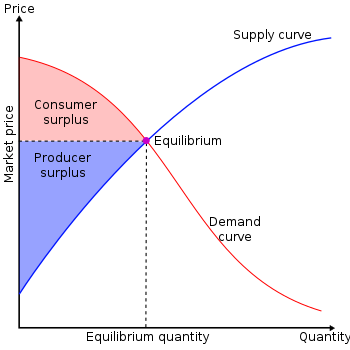Consumer surplus: Difference between revisions
No edit summary |
Edwardmking (talk | contribs) ←Undid revision 114542098 by 138.251.71.19 (talk) |
||
| Line 2: | Line 2: | ||
'''Consumer surplus''' or '''Consumer's surplus''' (or in the plural '''Consumers' surplus''') is the difference between the price consumers are willing to pay (or [[reservation price]]) and the actual [[price]]. If someone is willing to pay more than the actual price, their benefit in a transaction is how much they saved when they didn't pay that price. For example, a person is willing to pay a tremendous amount for water since he needs it to survive, however since there are competing suppliers of water he is able to purchase it for less than he is willing to pay. The difference between the two prices is the consumer surplus. |
'''Consumer surplus''' or '''Consumer's surplus''' (or in the plural '''Consumers' surplus''') is the difference between the price consumers are willing to pay (or [[reservation price]]) and the actual [[price]]. If someone is willing to pay more than the actual price, their benefit in a transaction is how much they saved when they didn't pay that price. For example, a person is willing to pay a tremendous amount for water since he needs it to survive, however since there are competing suppliers of water he is able to purchase it for less than he is willing to pay. The difference between the two prices is the consumer surplus. |
||
Producer surplus is the difference between the actual market price and the reserve price of cusomters |
|||
== Calculation from supply and demand == |
== Calculation from supply and demand == |
||
Revision as of 03:07, 13 March 2007

Consumer surplus or Consumer's surplus (or in the plural Consumers' surplus) is the difference between the price consumers are willing to pay (or reservation price) and the actual price. If someone is willing to pay more than the actual price, their benefit in a transaction is how much they saved when they didn't pay that price. For example, a person is willing to pay a tremendous amount for water since he needs it to survive, however since there are competing suppliers of water he is able to purchase it for less than he is willing to pay. The difference between the two prices is the consumer surplus.
Calculation from supply and demand
The aggregate consumers' surplus is the sum of the consumer's surplus for each individual consumer. This can be represented on a supply and demand figure. The consumer surplus is the area under the demand curve and above a horizontal line at the equilibrium price. If the demand curve is a straight line, the consumer surplus is the area of a triangle:
For more general demand and supply functions, these areas are not triangles but can still be found using Integral Calculus. Consumer surplus is thus the definite integral of the demand function with respect to price, from the market price to the maximum reservation price (i.e. the price-intercept of the demand function):
where
The graph shows, that if we see a rise in the equilibrium price and a fall in the equilibrium quantity, then consumer surplus falls.
Distribution of benefits when price falls
When supply of a good expands, the price falls (assuming the demand curve is downward sloping) and consumer surplus increases. This benefits two groups of people. Consumers who were already willing to buy at the initial price benefit from a price reduction, and additional consumers who were unwilling to buy at the initial price but will buy at the new price and also receive some consumer surplus.
Consider an example of linear supply and demand curves. For an initial supply curve S0, consumer surplus is the triangle above the line formed by price P0 to the demand line (bounded on the left by the price axis and on the top by the demand line). If supply expands from S0 to S1, the consumers' surplus expands to the triangle above P1 and below the demand line (still bounded by the price axis). The change in consumer's surplus is difference in area between the two triangles, and that is the consumer welfare associated with expansion of supply.
Some people were willing to pay the higher price P0. When the price is reduced, their benefit is the area in the rectangle formed on the top by P0, on the bottom by P1, on the left by the price axis and on the right by line extending vertically upwards from Q0.
The second set of beneficiaries are new consumers, those who will pay the new lower price (P1) but not the higher price (P0). Their additional consumption makes up the difference between Q1 and Q0. Their consumer surplus is the triangle formed by on the left by the line extending vertically upwards from Q0, on the right by the demand line, and on the bottom by the line extending horizontally to the right from P1.
Rule of one-half
The rule of one-half estimates the change in consumers' surplus for small changes in supply with a constant demand curve. Following the figure above,
where:
- CS = Consumers' Surplus
- Q0 and Q1 are the quantity demanded before and after a change in supply
- P0 and P1 are the prices before and after a change in supply
Comparison to profit
In terms of supply and demand, consumer's surplus is the analog to producer's surplus.
History
The idea of consumer's surplus was due to Jules Dupuit and extended by Alfred Marshall.




